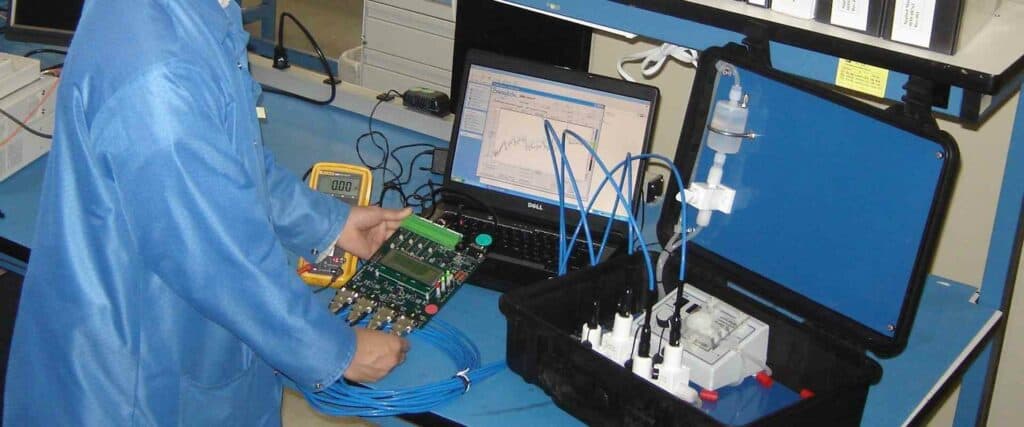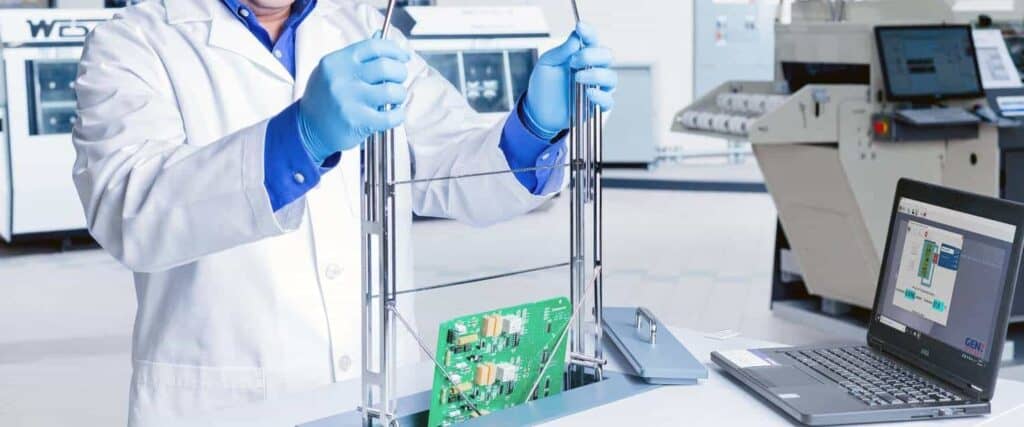Electronics environmental testing is an essential aspect of electronic design and manufacturing processes. It ensures the durability and reliability of electronic components and devices when exposed to various environmental conditions, such as temperature, humidity, pressure, or vibration. This process helps manufacturers identify potential flaws in their products early in the development phase and make necessary adjustments, resulting in improved product quality and extended service life.
These tests can be divided into various categories based on the factors they assess and the types of devices being tested. Some common categories include climatic testing, dynamic testing, and mechanical testing, each with its specific set of tests to verify the product’s performance under certain conditions. These tests simulate the environmental stresses commonly encountered by electronic equipment during normal operation, transportation, and storage.
Among the different types of tests conducted under these categories are thermal stress testing, vibration analysis, shock testing, and humidity testing. Each test type focuses on specific environmental factors and other related conditions, enabling designers and manufacturers to address potential issues in a targeted and efficient manner. With the help of these tests, the electronic industry can maintain the high standards for quality, performance, and safety that consumers and industries demand.

Definition of Electronics Environmental Testing
Electronics Environmental Testing is a systematic process that evaluates the performance and durability of electronic devices, components or systems under controlled environmental conditions. These conditions simulate the various potential environments that the electronics may encounter during their lifetime, such as temperature variations, humidity, dust, and vibration.
The primary purpose of environmental testing is to ensure that electronic products will function as intended in their intended applications, as well as to predict any potential failures, thus ensuring product reliability and safety. These tests are essential, as they help manufacturers and designers address potential design flaws, component incompatibilities, and other performance issues before the products reach consumers.
Three key categories of Electronics Environmental Testing include:
- Climatic Testing
- Dynamic Testing
- Combined Environmental Testing
-
Climatic Testing: These tests deal with the effects of various climatic factors on electronic devices, such as temperature, humidity, and altitude. Some common climatic tests include Temperature Cycling, Damp Heat, and Salt Spray tests.
-
Dynamic Testing: This category of tests aims to evaluate electronic devices’ performance under stress, such as mechanical shock, vibration, and impact. Some typical dynamic tests include Mechanical Shock, Random Vibration, and Bump tests.
-
Combined Environmental Testing: These tests consist of a combination of both climatic and dynamic testing parameters, enabling manufacturers to assess electronic devices’ performance under multiple environmental stresses. Examples of combined environmental tests include Temperature-Altitude-Vibration tests and Highly Accelerated Life Test (HALT).
Category of Environmental Tests

Aerospace
Aerospace environmental testing ensures the reliability and performance of electronic components and equipment used in aircraft and spacecraft. These stringent tests are designed to simulate extreme environmental conditions, such as temperature fluctuations, humidity, shock, and vibration. Some common aerospace environmental tests include:
- Temperature and humidity testing
- Thermal shock testing
- Vibration and shock testing
- Salt fog testing
Automotive
Environmental testing in the automotive industry ensures the performance and reliability of electronic components and systems in vehicles. These tests expose automotive electronics to various environmental stressors, such as temperature, humidity, and vibration. Common automotive environmental tests include:
- Temperature and humidity testing
- Thermal cycling testing
- Mechanical shock and vibration testing
- Dust and water ingress testing
Medical
Environmental testing for medical devices plays a critical role in ensuring the safety, reliability, and efficacy of electronic equipment used in healthcare settings. Medical device testing adheres to specific industry standards and guidelines. These tests might include:
- Temperature and humidity testing
- Thermal shock testing
- Accelerated aging testing
- Vibration and shock testing
Military
Military environmental testing subjects electronic components and equipment to rigorous testing procedures designed to replicate the harsh conditions of military applications. These tests ensure the reliability, performance, and survivability of electronic systems on the battlefield. Some common military environmental tests include:
- Temperature and humidity testing
- Thermal shock testing
- Vibration and shock testing
- Electromagnetic interference testing
Different Types of Tests
Vibration Testing
Vibration testing is essential for assessing a product’s durability and reliability under various levels of mechanical stress. It simulates the vibrations that electronic devices might encounter during transportation or daily usage. This test helps identify any potential design flaws or weaknesses in the product, which can then be corrected before mass production.
- Sine sweep test: Measures a device’s response to a continuous change in frequency.
- Random vibration test: Exposes the device to various frequencies, amplitudes, and spectrums.
Thermal Cycling
Thermal cycling tests expose electronic devices to temperature extremes by cycling through a pre-determined temperature range. This testing is essential for identifying temperature-induced stresses and ensuring that electronic components perform optimally in different environments.
- Rapid thermal cycling: Devices undergo rapid temperature fluctuations.
- Slow thermal cycling: Devices experience gradual temperature changes over an extended period.
Salt Spray Testing
Salt spray testing simulates environmental conditions to test the corrosion resistance of a product. This test is particularly relevant for electronic devices exposed to harsh environments or high humidity levels. By assessing the product’s resistance to corrosion, manufacturers can improve material selection or implement protective coatings.
- Neutral Salt Spray (NSS) test: Device exposed to a neutral salt solution.
- Acetic Acid Salt Spray (AASS) test: Device exposed to a more aggressive acetic acid salt solution.
Shock Testing
Shock testing is critical for evaluating the performance and resilience of electronic devices when subjected to sudden forces, impacts, or acceleration changes. This type of testing is beneficial in anticipating possible operational hazards during product development.
- Classical shock testing: Imparting sudden, predefined forces on the device.
- Shock response spectrum (SRS) test: Evaluating how the device responds to a shock event with a frequency range.
Each of these tests plays a crucial role in ensuring the reliability and performance of electronic devices in various environmental conditions. The test results aid manufacturers in improving product quality and resiliency against potential hazards during the device’s lifecycle.
Importance and Benefits of Environmental Testing

Environmental testing in electronics plays a crucial role in ensuring the reliability, safety, and longevity of electronic products. By simulating harsh environmental conditions, testing helps manufacturers identify potential issues and make necessary adjustments before products go to market.
One of the main benefits of environmental testing is the verification of product performance. Through various tests, manufacturers can ensure that their products meet industry standards and perform as expected under different conditions. This can lead to higher customer satisfaction and reduced risk of product recalls or repairs.
Environmental testing also contributes to improved product designs and materials. By exposing products to various conditions, designers can better understand how different materials and components react under stress. This knowledge can result in improved designs and more robust products.
In addition, environmental testing can lead to cost savings for manufacturers. By identifying potential issues early in the development process, manufacturers can avoid costly redesigns, recalls, or warranty claims. This can ultimately make the production process more efficient and cost-effective.
Finally, environmental testing helps ensure that electronic products are compliant with relevant regulations and standards. By meeting these requirements, manufacturers can avoid fines, legal issues, and damage to their reputation.
In summary, environmental testing is essential for ensuring the quality, safety, and reliability of electronic products. By exposing products to various test conditions, manufacturers can identify potential issues, improve designs, and meet industry standards and regulations. This ultimately leads to better products and a more efficient production process.
Conclusion
Electronics environmental testing plays a crucial role in ensuring the reliability and durability of electronic devices in various conditions. By subjecting devices to these tests, manufacturers can identify potential weaknesses and improve their products’ performance.
The different categories of testing, such as climatic, mechanical, and combined environment tests, assess a device’s resilience against temperature, humidity, shock, and vibration, among other factors. These categories comprise various tests such as thermal shock, salt spray, and HALT, each with distinct purposes.
By understanding and adequately performing these tests, manufacturers can enhance device quality, reduce maintenance costs, and improve user satisfaction. As electronics become increasingly integrated into our lives, the importance of environmental testing cannot be overstated.

